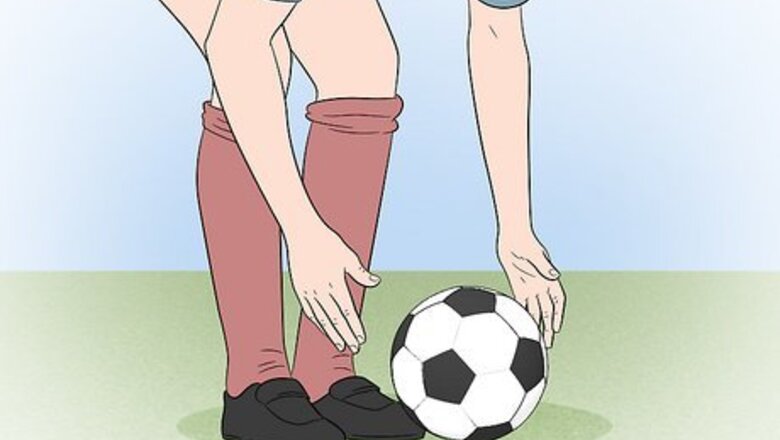
views
Shooting a Penalty Kick
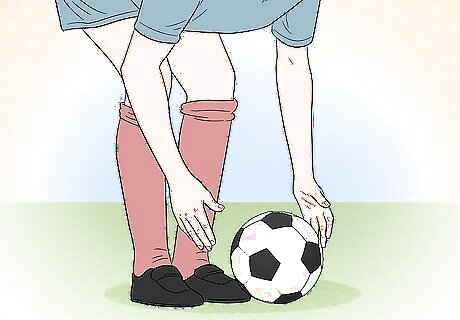
Place the ball yourself. Don't let the referee, the goalie, or some other player place the ball for you. You're the one doing the kick, so you should be the one to place the ball on the penalty marker. Run your hand through the grass to get any clumps, rocks, or sticks out of the way, then place the ball as high up on the grass as possible. Ideally, the ball should be fluffed slightly on the grass to give yourself the best chance of striking it clean. If the spot is worn down, don't worry too much. Kicking it along the ground is a high-probability shot, anyway. Just make sure you account for the ball's height in your approach.

Take three or four steps back. Plant the ball, then step backward three steps, and take one step to the side of your non-kicking foot. You don't have far to kick the ball, and most players only need one approaching step and one plant step to get enough power behind the ball to score a penalty. More than that is usually unnecessary, but do what feels comfortable. Practice different approaches and find out what works best for you. Some players think taking a running start from mid-field will give you more power in your shot. While that may look intimidating, the truth of it is that you'll have to slow down as you approach the ball, to make sure you don't end up planting on the wrong foot. Taking fifty steps to shoot a penalty kick accomplishes nothing but tiring you out.
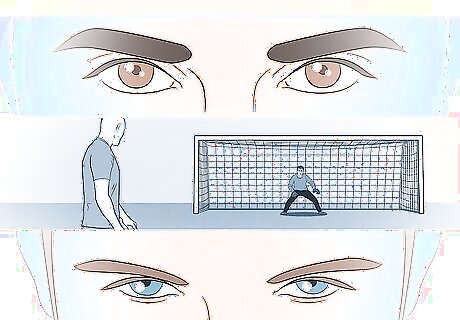
Win the psychology game first. Don't look at the keeper, listen to your opponents chattering, or pay attention to what anyone is saying. Silence the field, look at the ball, and think about what you're doing. Nothing else matters right now but putting the ball in the back of the net. The keeper will probably be jumping around, waving arms, and acting confident. This is because the keeper knows you're about to score. Stay focused and stay calm, and you'll be that much closer to a goal. Alternatively, if you're feeling alpha, stare the keeper down for all you're worth. Burn a hole through the back of the net with your eyes. Intimidate your opponent. Statistically, more penalties are missed than are saved. Your biggest opponent in the penalty kick is not the goalkeeper, but yourself. Remember that.
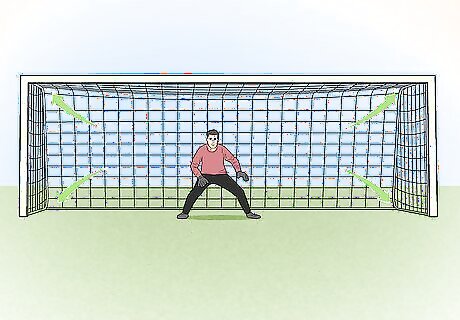
Pick a spot to aim and stick to it. The best place to shoot a penalty kick? Wherever feels most comfortable for you. Penalty kicks are a high-probability shot anywhere on the net, but thinking too hard causes a lot of players to get in their own way, and change their decision at the last minute. You're not going to see anything in the split second before you kick that will help you change your mind. Pick a spot and be confident that it's correct. Remember this golden rule, "The spot once chosen for placing the kick must never be changed. No second thoughts." Statistically, it's true that most penalty kicks are scored in the bottom left corner of the net. The top left corner is the second-highest percentage, followed by the bottom right corner. This is because most players are right-footed, and hook the ball left naturally. When in doubt, keep the ball low. Shots aimed at the upper corners are the most seldom saved, but the most often missed. If you're a very accurate shooter, you give yourself the best chance with a shot aimed at the upper post, but statistically the chances of missing are much higher.

Relax and breathe. When you've placed the ball and decided where you're shooting, just relax. Feel confident. More than 70% of penalty kicks end with goals. Focus on the task at hand, the mechanics of the shot, and wait for the referee's whistle. Tell yourself you're going to score. Without staring at the spot where you're going to shoot, visualize the shot going past the goalie and into the net. Visualize yourself following through, striking the ball clean and hard, and scoring the goal for your team. When you hear the referee's whistle, it's best to go as quickly as possible and not give yourself too much time to think about it and make a bad decision. You don't need to psych out the goalie any more. The time is now.
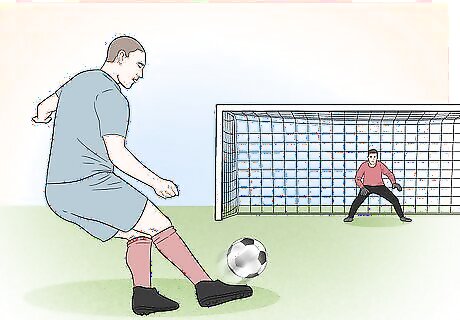
Strike the ball with your instep. Plant your non-kicking foot a few inches to the side of the ball and drive into it with the instep of your kicking leg. This offers you the best control over the ball, allowing you to drive it into the spot of your choice, and into the back of the net. Follow through with your kicking motion, driving your leg up and pointing your toe where you want the ball to go. Curveballs are all about the follow through. The more you practice this technique, the better you'll be able to manipulate the ball in different ways. Some players like to use the laces, driving over the ball to put more power behind it, which is also a perfectly-fine way of kicking. This typically offers less accuracy, but more power. If you want the ball to go high, plant your plant foot just behind the ball and lean over it to keep it down low enough to stay under the bar. You need to do this if you want to aim for the top corner. If you want the ball to stay on the ground, use your instep and drive through the ball hard. Don't try to get too fancy with your aim. It doesn't need to skim off the post, it just needs to find net.
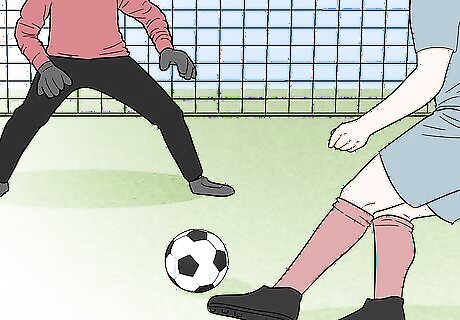
Let your teammates get a rebound, if there is one. If you should miss, be careful before you charge in and take another shot. Another player, whether it be an opponent or a teammate, needs to touch the ball before you do. If the goalkeeper makes a save, but the ball bounces free, run to it as fast as you can and try to get it in the net. If you drive the ball off the post, another player has to touch it first, or you'll be called for a foul.
Practicing Penalty Kicks
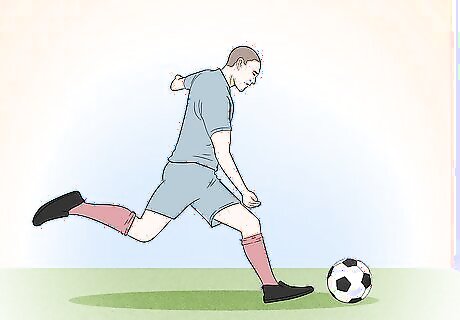
Develop a repertoire of shots. You should have no more than three options for shots any time you get up to the box to take a penalty kick in soccer. Don't make it more difficult on yourself than it needs to be. Practice taking three differently placed penalty kicks, and call that your repertoire of shots. Perfect each one of them, so you know you'll be able to score in any of the three places when the time comes and you make that decision. Wherever your most comfortable, highest-probability shots are, practice them and don't worry about any other choices. Most goalies will dive left or right at random, making it very difficult to anticipate where the goalie will be when you shoot. Since it happens so quickly, you're playing a game of chance, always. If the goalie is familiar with your style of play, however, it's good to have a few go-to options in your bag at all times. Again, more shots are missed than saved, so it's mostly up to you. Most saves happen in the bottom right corner of the goal. Some goalies guess that right-footed kickers will try to outsmart them by going to the non-natural corner. It's best to go easy and uncomplicated the process. Shoot to the corner that feels best.
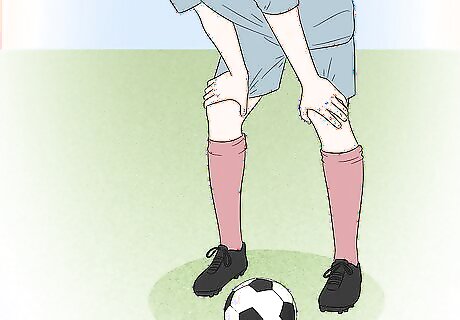
Take penalty kicks when you're tired. Anyone can blast a ball into the back of the net a couple times, but what about when you've been going hard on the field for half an hour, fighting for balls, taking corner kicks. Your legs will be tired, you'll be sweaty and exhausted and all of a sudden all the eyes will be on you. Your legs might feel like lead, but you've got to come through with a brilliant goal that'll put your team ahead. Train the right way. Take penalty kicks when you're tired and learn to slow down and calm yourself, focusing on the mechanics and the motions to help yourself score.
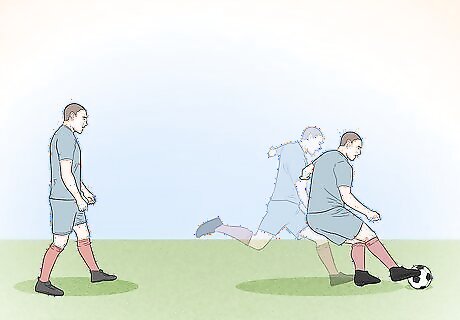
Measure your approaches and practice different steps. For some players, a two-step approach will be plenty to get the power they're looking for. Others might need a different amount of steps, or may want to play around with psyching out the goalkeeper with different approaches and fancy footwork. That's fine. Practice approaching your kicks from different steps back and see what feels the most comfortable for you. Some players like to take a few more steps back to force a stutter-step, a few little quick strides before driving into the ball. This helps to throw the timing of the goalie off, and can force the keeper to jump early, meaning that you might be able to shoot into an open net.

Practice with distractions. Again, easy to blast balls into an open net. Practice with a keeper who's trash talking. Practice while your little brother makes fun of you from behind, telling you that you're going to miss. Practice when there's loud music playing, bugs howling, and it's raining out. Practice in the worst conditions and you'll be prepared for anything.
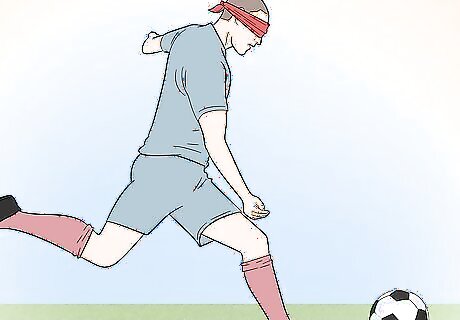
Practice blind. Time to get zen on the PK game. If you want to really take your penalty kick shooting to the next level, practice them with your eyes closed. Literally. The distance from the penalty spot to the goal and the dimensions of the goal will be identical every time you want to take a penalty kick. This means that your approach, your mechanics, and your shot-placement should be automatic. You should be able to do this with your eyes closed. Why not try it?











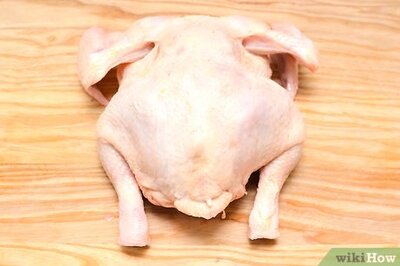








Comments
0 comment